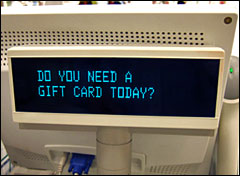Think all news is bad news during this epic recession of ours? Think again — over the past three months, real wages have increased 23 percent, an enormous gain. At a crucial period for many working families, paychecks are going a lot farther than they did back in the summer.
The explanation is simple: wages are flat, prices are down. The labor market operates on a bit of a lag, so while the recession affected oil demand and prices very quickly, layoffs and falling wages are emerging more slowly. Eventually, the weak economy will catch up to workers (those who still have jobs), and spending power will decline.
But this is important to remember given the trends of the past decade. When economies are growing, oil prices rise. This means that even while wages are growing, it’s difficult for consumer spending power to keep up, unless we reduce the intensity of oil in our economy. How can we do this? Easy — cut commuting times, reduce driving, reduce congestion, green intercity travel and green freight shipping (so that rising oil prices don’t feed through to prices for other goods, including food).
This, of course, is the logic behind a push for greener infrastructure. Better transit and rail systems boost productivity — by improving movement of goods and people — which increases wages. They also reduce the petroleum intensity of the economy. In a boom period, you then have rising wages that aren’t much eroded by rising energy costs. And that means a richer and greener society.
Barack Obama understands this; at least, that’s what we’ve been led to believe by his speeches. Many Congressional leaders understand it too. And it is therefore very disappointing to see the contents of the new American Recovery and Reinvestment Act — also known as the stimulus bill. As has been widely reported, roughly $30 billion of the proposed infrastructure spending will go to highways, while only $10 billion is allocated toward transit and rail.
Optimists might see this as a reflection of the shovel-readiness of various initiatives, but that doesn’t seem to be the case. The bill itself reflects that more could have been done. A line item allocating $6 billion to transit capital programs concludes:
The Department of Transportation’s 2006 Conditions and Performance Report indicated there is an annual investment gap of $3.2 billion to maintain our transit systems and an annual gap of $9.2 billion to begin to improve our transit systems. In addition, a January 2009 survey of the American Public Transportation Association (APTA) identified 787 ready-to-go transit projects totaling $15.9 billion.
Elsewhere it identifies unmet transit and rail needs totaling $78 billion.
What’s more, the horizon of the bill is longer than many anticipated. The Congressional Budget Office reports that of the $355 billion in federal stimulus spending, only $26 billion will be used in 2009. Over $200 billion will be spent between 2011 and 2019. Within a ten-year window, the scope for useful spending on transit and rail is nearly unlimited. The lack of transit spending is unquestionably political, and not logistical, in nature.
The possibility remains that the Congressional leadership and the Obama administration are waiting for the 2009 transportation bill overhaul to adjust spending priorities, and indeed, that vote will be hugely important for the future of the nation’s infrastructure. There may also be scope for funding in Obama’s energy bill. But there is reason for concern here.
The security of our economy and our environment depend upon a sea change in transportation planning. That transit and rail were so easily sacrificed in stimulus negotiations should send us a message — now is no time for transit supporters to ease up on their legislators. We’ll need to fight until the money is in the pipeline.


